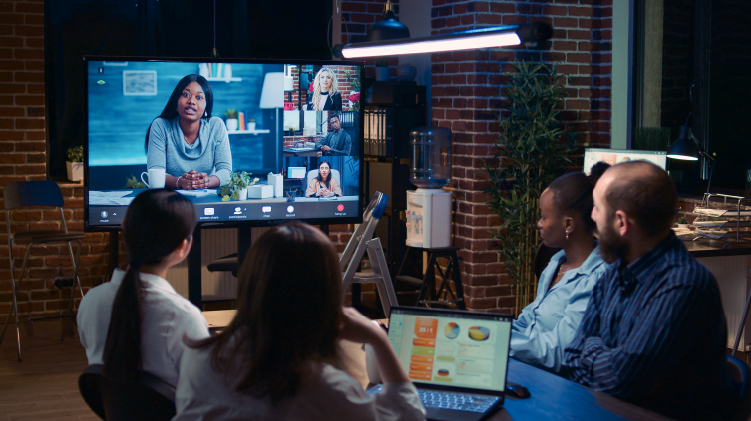The buzz around “return to office” (RTO) has been loud. Companies are trying various approaches to entice their employees back to work in person. But one thing remains clear: hybrid collaboration is here to stay.
This means video conferencing is a permanent fixture and a smooth RTO hinges on using it for effective communication among on-site employees, their remote colleagues, and external clients or collaborators.
Current State of RTO: A Mixed Bag
RTO policies vary widely across industries and organizations. Some companies have mandated a full return1 while others, like Citigroup, embrace a hybrid model2 as a competitive advantage to recruit employees who prefer less rigid working arrangements.
As of Q4 20243, structured hybrid models were used by 43% of U.S. organizations, more than double the rate from 20% in early 2023. Most companies set minimum weekly office hours, allowing teams flexibility on when to come in, which averages around three days a week. Policies requiring just one or four days in the office are not common, with only 5% of U.S. companies adopting them. Overall, companies are still exploring ways to strike the right balance between in-person attendance and flexibility.
Vital Role of Video Conferencing in RTO

No matter the approach taken, having effective communication tools is crucial for team collaboration. Video conferencing enhances clarity in hybrid environments and reduces the potential for delays and misunderstandings from emails or phone calls. This keeps remote team members connected and engaged, thereby promoting a sense of belonging despite physical distance.
But the benefits extend beyond connecting remote workers. Even within the physical office, video conferencing enhances productivity. Team members may be dispersed across multiple floors or buildings. Instead of trekking across the office for impromptu meetings and sharing information on their laptops, they can use dedicated meeting rooms to video conference and collaborate with more efficient use of screen time.
That is where top-notch camera solutions come in. Intelligent auto tracking cameras ensure that everyone is seen and heard clearly. It’s especially useful for capturing the dynamics of in-person get-togethers, such as when people join and leave meetings. A dual-lens camera design like AVer’s CAM570 combines precise real-time motion and audio detection with a comprehensive view of the room. When a new participant enters, the AI-powered lens triggers the PTZ camera to re-frame, instantly capturing everyone to ensure a smooth flow of the meeting and saving valuable time and resources.
Challenges and Solutions
Of course, RTO has its challenges. Employees may struggle with the transition back to the office, missing the flexibility of remote work. Meanwhile, employers need to ensure that the office environment is conducive for both individual focused work and collaborative team activities, while also promoting equitable participation in meetings for both in-office and remote attendees.
Setting up dedicated spaces is a key part of accommodating hybrid work modes. And that’s where high-quality AV equipment makes all the difference. Well designed, they create a more inclusive and collaborative work environment that eases the transition back to the office.
Here, AVer has a wide range of solutions to suit different room sizes, including PTZ cameras and video bars for small to large rooms. Noise cancellation and echo suppression features help establish a more distraction-free and productive environment for meetings. What’s more, pairing of a wide-angle camera and ceiling-mounted speakerphone, such as the FONE700 and CAM550, allows participants to simply walk in, connect, and start talking without concerns about camera visibility or microphones audio.
At the same time, it’s important to establish clear guidelines for video conferencing etiquette, including best practices, such as muting and unmuting during a virtual call or procedures for reserving meeting rooms. Additionally, providing comprehensive training and support for employees is key to helping everyone feel confident and comfortable using the video conferencing equipment and software.
Looking Ahead
Video conferencing is an integral part of employees returning to the office. As businesses embrace and manage hybrid work, the ability to connect and collaborate across locations is critical.
On that basis, on-site video conferencing solutions must cater to diverse user preferences, ranging from bring-your-own-device (BYOD) options to dedicated meeting room systems. It also means that AV equipment from various brands needs to work cohesively. As such, strategic partnerships that promote interoperability among a wide array of hardware and software solutions are key to delivering a seamless experience for users as they transition back to the office.
References
MSN. The list of major companies requiring employees to return to the office, from JPMorgan and TikTok to Amazon. ↑
Franklin, Joshua, and Stephen Gandel. 2025. Citi Bucks Back-to-office Trend and Embraces Hybrid Working. Financial Times, February 4, 2025. ↑
Kara Dennison. An Update on Return to Office Policies as We Enter 2025. Forbes, December 19, 2024. ↑